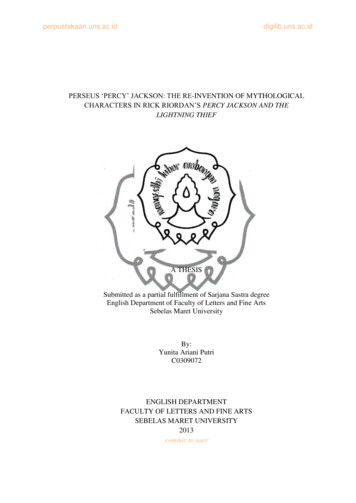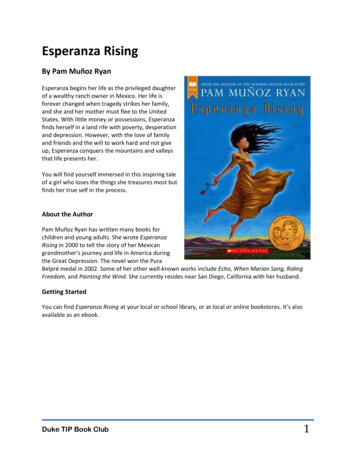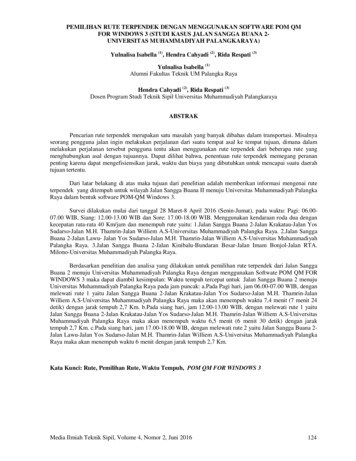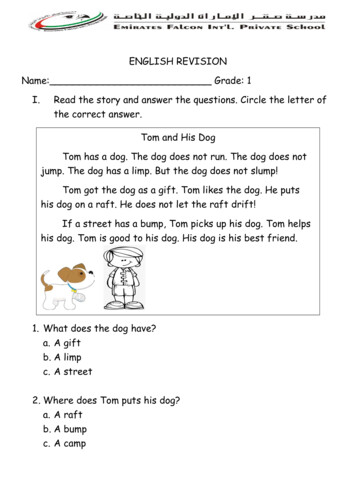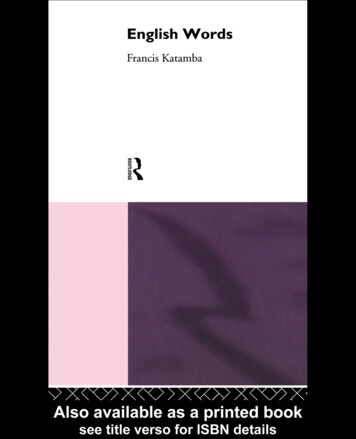
Transcription
English Words‘The air is always thick with our verbal emissions. There are so many things we want to tell the world.Some of them are important, some of them are not. But we talk anyway. A life without words would be ahorrendous privation.’(from the Introduction)Words and language, keys to human identity, are fascinating subjects. The aim of this book is to arousecuriosity about English words and about the nature of language in general, especially among students whoare not intending to specialise in linguistics.The book covers a wide range of topics, including the structure of words, the meaning of words, howtheir spelling relates to pronunciation, how new words are manufactured or imported from other languages,and how the meaning of words changes with the passage of time. It also investigates how the mind dealswith words by highlighting the amazing intellectual feat performed routinely when the right word isretrieved from the mental dictionary during conversation. Words of all sorts are examined—from greatpoetry, nonsense verse and journalism to advertising. It is demonstrated that in their very different waysthey are all worthy of serious study.This textbook is an accessible descriptive introduction, suitable for students of English language andcommunication, showing how the nature of words can be illuminated by insights from a broad range of areasof linguistics and related subjects.Francis Katamba is Lecturer in Linguistics at Lancaster University. His publications includeMorphology (1993) and Introduction to Phonology (1989).
English WordsFrancis KatambaLondon and New York
First published 1994by Routledge11 New Fetter Lane, London EC4P 4EEThis edition published in the Taylor & Francis e-Library, 2005.“To purchase your own copy of this or any of Taylor & Francis or Routledge’s collection of thousands of eBooks please go towww.eBookstore.tandf.co.uk.”Simultaneously published in the USA and Canadaby Routledge29 West 35th Street, New York, NY 10001 1994 Francis KatambaAll rights reserved. No part of this book may be reprinted orreproduced or utilised in any form or by any electronic,mechanical, or other means, now known or hereafterinvented, including photocopying and recording, or in anyinformation storage or retrieval system, without permissionin writing from the publishers.British Library Cataloguing in Publication DataA catalogue record for this book is available from the British Library.Library of Congress Cataloging in Publication DataKatamba, FrancisEnglish words/Francis Katambap. cm.Includes bibliographical references.1. English language—Lexicology. I. TitlePE1571.K38 1994423 .028–dc20 93–33393ISBN 0-203-20528-6 Master e-book ISBNISBN 0-203-20531-6 (Adobe eReader Format)ISBN 0-415-10467-X (hbk)ISBN 0-415-10468-8 (pbk)
ToJanet,Francis and Helen
ivKey to symbols usedxviIntroduction11.1Why study words?11.2Overview of coming chapters4What is a word?62.1Introduction62.2Words are like liquorice allsorts722.2.1Word-forms2.2.2Words as vocabulary items112.2.3Grammatical words152.37Summary17Exercises18Close encounters of a morphemic kind193.1The quest for verbal atoms193.2Close morphological encounters: zooming in on morphemes193.3Morphemes and their disguises223.3.1Allomorphs: morph families223.3.2Contrast2533.4Freedom and bondage263.5Sound symbolism: phonaesthemes and onomatopoeia273.6Verbal blueprints28
vi3.6.1Tiny words (isolating languages)303.6.2Get the glue (agglutinating languages)313.6.3Labyrinthine words (synthetic languages)313.6.4Verbal juggernauts (polysynthetic languages)333.6.5No thoroughbreds333.7Summary35Exercises35Building words374.1Words and jigsaws374.2Know the pieces of the jigsaw3744.2.1Roots are the core374.2.2Affixes are for appending384.3The main types of word-building: inflection and derivation404.4Derivation: fabricating words414.4.1Affixation: prefixes and suffixes424.4.2Conversion484.4.3Compound parade494.4.4Wishy-washy words544.5Summary55Exercises55Masquerading allomorphs575.1The right mask575.2Phonologically conditioned allomorphs575.2.1Selecting underlying representations615.2.2Derivations6355.3Phonology in the shade: lexical and grammatical conditioning655.4Madness without method: suppletion665.5Summary66Exercises66A lexicon with layers696
vii6.1The nature of the lexicon696.2Morphological information in the lexicon706.3Syntactic information in the lexicon706.4Does it ring true (phonological information)716.5Rendezvous with lexical phonology and morphology716.5.1Neutral and non-neutral affixes726.5.2The lexicon is like a layered cake736.6Productivity, the time-warp and cranberries776.7Peeping beyond the lexicon796.8Summary80Exercises80Should English be spelt as she is spoke?837.1Writing systems837.2Is the English orthography mad?8477.2.1The apparent madness in the English spelling system857.2.2There is a method in the madness: spelling rules and pronunciation867.2.3Is A for apple? Why vowel letters pinch like ill-fitting shoes907.3Morphological signposts in the spelling947.4Lexical signposting in the spelling967.5Spelling reform967.6Is speech degenerate writing?99Exercises101Word manufacture1038.1The production line1038.2Keeping tabs on ds galore113A verbal bonanza113899.1
viii9.2Jargon1139.3Slang1149.4Clichés and catch-phrases1159.5A rose by any other name1199.5.1Semantic widening1209.5.2Semantic narrowing1219.5.3Going up and down in the world1229.5.4Loss account1229.5.5Lexical yms and abbreviations1269.8Fads and copycat Euphemism1299.12Summary131Exercises131A lexical mosaic: sources of English vocabulary133The nature of borrowing1331010.110.1.1Direct and indirect borrowing13310.1.2Loanwords and loanshifts13410.1.3Likely loans13510.1.4Why borrow?13510.1.5The grass is ever greener on the other side13810.1.6Nativisation of loanwords13910.1.7Effects of borrowing14210.2Scandinavian loanwords14310.3The French influence14410.3.1The Norman French legacy144
ix10.3.2French words in modern English14610.4Words from other modern European languages15010.5Loanwords from non-European languages15110.6The Germanic inheritance15210.7Summary154Exercises15411The mental lexicon15711.1A mind full of words15711.1.1Types of lexical information15811.1.2The organisation of the mental lexicon16011.1.3To parse or not to parse16111.2Modelling the mental lexicon16411.2.1Understanding speech16411.2.2Selective listening16611.2.3Exploiting syntactic and semantic clues16711.3The articulatory programme16911.3.1Speech errors as evidence in favour of the articulatory programme16911.3.2Two-stage models of lexical access in speech production17111.3.3It’s just on the tip of my Broca’s aphasia17611.4.2Wernicke’s aphasia17711.5Freudian slips17811.6The spreading activation ences190Indexes195
PrefaceThis book developed out of a course on English words that I have taught at Lancaster over the last fewyears. It is intended to arouse curiosity about English words and about language in general, especiallyamong students who are not intending to specialise in linguistics.Is it not strange that we spend so many of our waking hours talking and yet we know so little aboutwords? Putting words under a microscope and peering at them seems to be a dead boring and absolutelyunrewarding subject. Most people know more about sport, cars, computers, gardening, virtually aboutanything than they know about words. If you are one of them, then read on.This book was written for you. It is intended to disabuse you of the false impression that investigating wordsis tedious, dry and totally unenjoyable. English Words takes you on a voyage of discovery during which youfind out how words are structured, how they convey meaning, how their spelling relates to pronunciation,how new words are manufactured, how the meaning of words changes as time passes and how words areimported from other languages. Finally, in the concluding chapter we marvel at the ability you and I have tostore tens of thousands of words in our minds and to retrieve the right words instantaneously inconversation. All this is exciting stuff.Traditionally, the student is not offered a single course or course-book that covers all the various topicsthat I have listed above. My aim in departing from normal practice by covering such a wide range of topicsin one book is to provide a synthesis of what linguists and students of neighbouring disciplines such aspsychology have found out about words. So, this book gives a panoramic view of words in the Englishlanguage. I think there is some virtue in making sure that students do not concentrate so hard on seeing thetrees that they miss the forest.Another feature of the book is that it is primarily a descriptive study of words in the English language. Itis only very occasionally that the structure of words in other languages is discussed.No previous knowledge of linguistics is assumed. I keep linguistic theory and jargon mostly in thebackground and focus on the description. Studying the contents of this book will not turn you into amorphologist, but it will teach you a lot of things about English.Your involvement in learning about English words is important. You will not be invited to watch all theinteresting things about words from a distance as a mere spectator. Plenty of examples and exercises areprovided for you to do some of the investigations yourself.It is my pleasure to thank many people who have helped me in various ways during the preparation ofthis book. First, I acknowledge the help of my family. The writing and preparation of the book would havebeen an even more arduous task without their constant support and active help in hunting for examples andillustrations.
xiI am also grateful to various other people whose comments, advice and support have been very useful. Ithank Claire L’Enfant, Senior Editor at Routledge, who started it all when she invited me to undertake thisproject and would not take no for an answer. In addition, I would like to thank the editorial and design staffat Routledge, in particular Beth Humphries and Emma Cotter for their advice and help in the preparation ofthis book. Next, I would like to thank in a special way first-year undergraduates on Course LING 152:English Words at Lancaster over the last couple of years who have been such co-operative, critical andreally excellent guinea pigs.I am also grateful to a number of colleagues and friends. I thank Jenny Thomas, Mick Short and KeithBrown, who commented on part of an early draft. And I thank Ton That Ai Quang from whom I receivedthe Vietnamese data. Finally, above all, I am indebted to Dick Hudson and an anonymous American readerwho went through the entire manuscript thoroughly and provided numerous useful comments andsuggestions on matters of substance and presentation. The book is much better in every way than it wouldotherwise have been without their assistance. Any imperfections that still remain are my responsibility.Francis KatambaLancaster, 1993
Acknowledgements‘Appellation controlée’. In 40 Ans de politiques. Musée des Arts Décoratifs. Paris: Flammarion.Auden, W.H. ‘Musée des Beaux Arts’. In W.H.Auden (1968) Collected Poems. Edited by EdwardMendelson. London: Faber.Bliss, A.J. (1966) Dictionary of Foreign Words and Phrases in Current English. London: Routledge &Kegan Paul.Burns, R. (1786) ‘Address to the devil’ in W.Beattie and H.W.Meikle (eds) Poems and Songs of RobertBurns. Harmondsworth: Penguin.Carroll. L. (1982) Alice’s Adventures in Wonderland and Through the Looking-Glass. Harmondsworth:Penguin Books. First published in 1865 and 1872 respectively. Illustration of Humpty Dumpty (from p.270) and the quotation (from p. 274).Chaucer, G. (1964) The Canterbury Tales, edited by A.Hieatt and C.Hieatt. New York: Bantam Books.Chirol, L. (1973) Les ‘mots français’ et le mythe de la France en anglais contemporain. Paris: EditionsKlincksieck.Cole, W. and U. and Ungerer, T. (1978) Oh, What Nonsense! A Collection of Nonsense Verse. London:Methuen.Crystal, D. (1987) The Cambridge Encyclopaedia of Language. Cambridge: Cambridge University Press.Dahl, R. (1982) The BFG. Harmondsworth: Puffin Books. BGF text and cartoon.Eliot, T.S. (1963) Collected Poems (1963). London: Faber & Faber. ‘Rhapsody on a Windy Night’(1954).English children’s rhyme ‘Beg parding’ in W.Cole (1968) Oh, What Nonsense, London: Methuen, p. 85.Fantoni, B. (1984) Private Eye’s Colemanballs 2. London: Private Eye/André Deutsch.Gairdner, J. (ed.) (1983) The Paston Letters. Gloucester: Alan Sutton. Vol. 2, pp. 46–8.Gleason, H.A. (1961) An Introduction to Descriptive Linguistics. New York: Holt, Rinehart & Winston.2nd edition, p. 414.Hopkins, G.M. (1970) ‘Spring and Fall’ in W.H.Gardner and N.H. MacKenzie, The Poems of GeraldManley Hopkins. Oxford: Oxford University Press.James, Henry, Portrait of a Lady. Harmondsworth: Penguin, p. 5.Kwik Fit advert in Lancaster Citizen Newspaper 24 June 1993.Lawrence, D.H. (1960) ‘Love among the Haystacks’ (1930) in Love among the Haystacks and OtherStories. Harmondsworth: Penguin, p. 13; London: Methuen, p. 85.Milligan, S. ‘Questions, Quistions & Questions’ in W.Cole (1972) Oh, That’s Ridiculous. London:Methuen, pp. 16–17.Mr. Punch’s Victorian Era (1888) ‘Humble Pie’ (1872). London: Bradbury, Agnew.
xiiiMr. Punch’s Victorian Era (1888) ‘Chef Sauce’ (1872). London: Bradbury, Agnew.Opie, I. and Opie, P. (1980) A Nursery Companion. Oxford: Oxford University Press.Philips, M. ‘Another day, another scandal’. The Guardian, 16 January 1993, p. 24.Sampson, G. (1985) Writing Systems: A Linguistic Approach. London: Hutchinson, p. 195, Figure 31.Shakespeare, W. The Oxford Shakespeare: Complete Works. Oxford: Oxford University Press.Quotations from: Henry V, IV, iii. Romeo and Juliet, II, ii. Sonnet 69. The Tempest, Epilogue.Sheridan, R.B. The Rivals in C.Price (ed.) (1975) Sheridan Plays. London: Oxford University Press. I, ii.Standens advert. What Hi-Fi, June 1993, p. 138. Reproduced by courtesy of Standens (Tonbridge)Limited.Vidal, J. ‘The big chill’. An extract from The Guardian, 19 November 1992.Winchester, S. (1993) The Guardian (Saturday magazine), 12 June, p. 27.Young, J. and Young, P. (1981) The Ladybird Book of Jokes, Riddles and Rhymes. Loughborough:Ladybird Books, pp. 40, 57.Yves St. Laurent advertisement. The Guardian (Saturday magazine), 30 June 1992.
PPPres.RPSAdjectiveAdverbAffixAgentBasic verbal suffix which is normally -aClassiferDeterminerFull Listing HypothesisFrenchHabitualIndicative moodInstrumental caseMiddle EnglishNounNoun PhraseObjectOld EnglishOxford English DictionaryOld Norse3rd person singularPronounParticipial moodPatientPluralPrepositional phrasePresentReceived PronunciationSentence
xv1s.Sing./sg.Subj.VVenVingVPWP1st person singularSingularSubjectVerbVerb ending in -en (past participle)Verb ending in -ing (present participle)Verb phraseWord-and-paradigm
Key to symbols used1.SYMBOLS FOR PHONEMESA key word for each phoneme is given, first in ordinary spelling and then in phonemic transcription. Thephonemic transcription represents the pronunciation in British Received t//set//sæt//m d//dg//gUd//sende//eb sawzoofur/si:d//ba:r//s/zu://f n//bæn//tæn/fVfanvanthin/fæn//væn// In/
illongleapripyeswin/t est//dest//meIl//neIl//l rehop2.NON-PHONEMIC SYMBOLSGlottal stop as in water/w:e/ as said in accents where between vowels the t ‘can be swallowed’.Dark 1.Clear 1.(Under a consonant) syllabic consonant as in kettle [ket].3.OTHER SYMBOLS· '*//[] ()The symbol over a vowel indicates that it is a long vowel.A raised dot indicates that the preceding vowel is stressed (in examples from OED).Is derived from.Becomes, develops into.Marks main stress on the following syllable.Secondary stress.An asterisk shows that a given form is disallowed.Slashes indicate a broad or phonemic transcription which only shows phonemes.Square brackets indicate a narrow (i.e. detailed) transcription that shows allophones.This indicates that forms alternate.Rewrite as; or becomes (depending on context).Optional items are put in parenthesis./en//si:l//zi:l// ip//mee//hp/
xviii4.SMALL CAPITALSSmall capitals are used for technical terms when first introduced and occasionally thereafter to highlighttheir technical sense.
Chapter 1Introduction1.1WHY STUDY WORDS?Imagine a life without words! Trappist monks opt for it. But most of us would not give up words foranything. Every day we utter thousands and thousands of words. Communicating our joys, fears, opinions,fantasies, wishes, requests, demands, feelings—and the occasional threat or insult—is a very importantaspect of being human. The air is always thick with our verbal emissions. There are so many things wewant to tell the world. Some of them are important, some of them are not. But we talk anyway—even whenwe know that what we are saying is totally unimportant. We love chitchat and find silent encountersawkward, or even oppressive. A life without words would be a horrendous privation.It is a cliché to say that words and language are probably humankind’s most valuable single possession. Itis language that sets us apart from our biologically close relatives, the great primates. (I would imagine thatmany a chimp or gorilla would give an arm and a leg for a few words—but we will probably never knowbecause they cannot tell us.) Yet, surprisingly, most of us take words (and more generally language) forgranted. We cannot discuss words with anything like the competence with which we can discuss fashion,films or football.We should not take words for granted. They are too important. This book is intended to make explicitsome of the things that we know subconsciously about words. It is a linguistic introduction to the nature andstructure of English words. It addresses the question ‘what sorts of things do people need to know aboutEnglish words in order to use them in speech?’ It is intended to increase the degree of sophistication withwhich you think about words. It is designed to give you a theoretical grasp of English word-formation, thesources of English vocabulary and the way in which we store and retrieve words from the mind.I hope a desirable side effect of working through English Words will be the enrichment of yourvocabulary. This book will help to increase, in a very practical way, your awareness of the relationship betweenwords. You will be equipped with the tools you need to work out the meanings of unfamiliar words and tosee in a new light the underlying structural patterns in many familiar words which you have not previouslystopped to think about analytically.For the student of language, words are a very rewarding object of study. An understanding of the nature ofwords provides us with a key that opens the door to an understanding of important aspects of the nature oflanguage in general. Words give us a panoramic view of the entire field of linguistics because they impingeon every aspect of language structure. This book stresses the ramifications of the fact that words arecomplex and multi-faceted entities whose structure and use interacts with the other modules of the grammar
2ENGLISH WORDSsuch as PHONOLOGY, the study of how sounds are used to represent words in speech, SYNTAX, thestudy of sentence structure, and SEMANTICS, the study of meaning in language.In order to use even a very simple word, such as frog, we need to access various types of informationfrom the word-store which we all carry around with us in the MENTAL LEXICON or DICTIONARY thatis tucked away in the mind. We need to know:[1.1](i)its shape, i.e. its PHONOLOGICAL REPRESENTATION/frg/ which enables us to pronounce it, and itsORTHOGRAPHIC REPRESENTATION frog, if we are literate and know how to spell it (see the Key tosymbols used on page xix);(ii) its grammatical properties, e.g. it is a noun and it is countable—so you can have one frog and two frogs;(iii) its meaning.But words tend not to wear their meaning on their sleeve. Normally, there is nothing about the form ofwords that would enable anyone to work out their meaning. Thus, the fact that frog refers to one of thesesimply has to be listed in the lexicon and committed to memory by brute force. For the relationship betweena LINGUISTIC SIGN like this word and its meaning is ARBITRARY. Other languages use different wordsto refer to this small tailless amphibian. In French it is called (la) grenouille. In Malay they call it katak andin Swahili chura. None of these words is more suited than the others to the job of referring to this smallreptile.And of course, within a particular language, any particular pronunciation can be associated with anymeaning. So long as speakers accept that sound-meaning association, they have a kosher word. Forinstance, convenience originally meant ‘suitability’ or ‘commodiousness’ but in the middle of the nineteenthcentury a new meaning of ‘toilet’ was assigned to it and people began to talk of ‘a public convenience’. Inthe early 1960s the word acquired the additional new meaning of ‘easy to use, designed for hassle-free use’as in convenience food.We are the masters. Words are our servants. We can make them mean whatever we want them to mean.Humpty Dumpty had all this worked out. The only thing missing from his analysis is the social dimension.Any arbitrary meaning assigned to a word needs to be accepted by the speech community which uses thelanguage. Obviously, language would not be much use as a means of communication if each individuallanguage user assigned a private meaning to each word which other users of the language did not recognise.Apart from that, it is instructive to listen in on the lesson on the nature of language that Humpty Dumptygave to Alice (see overleaf).Let us now consider one further example. All competent speakers of English know that you can add -s toa noun to indicate that it refers to more than one entity. So, you say cat when referring to one and cats ifthere is more than one. If you encountered in the blank in [1.2a] an unfamiliar word like splet (which I havejust made up), you would automatically know from the context that it must have the plural form splets inthis position since it is specified as plural by all. Further, you would know that the plural of splet must be splets(rather than spletren by analogy to children or spleti by analogy to stimuli). You know that the majority ofnouns form their plural by adding the regular plural suffix or ending -s. You always add -s unless expressinstructions are given to do otherwise. There is no need to memorise separately the plural form of mostnouns. All we need is to know the rule that says ‘add -s for plural’. So, without any hesitation, you suffix -sto obtain the plural form splets in [1.2b]:
INTRODUCTION3[1.2]a.b.We put all the big on the table.We put all the big splets on the table.The study of word-formation and word-structure is called MORPHOLOGY. Morphological theoryprovides a general theory of word-structure in all the languages of the world. Its task is to characterise thekinds of things that speakers need to know about the structure of the words of their language in order to beable to use them to produce and to understand speech.We will see that in order to use language, speakers need to have two types of morphological knowledge.First, they need to be able to analyse existing words (e.g. they must be able to tell that frogs contains frogplus -s for plural). Usually, if we know the meanings of the elements that a word contains, it is possible todetermine the meaning of the entire word once we have worked out how the various elements relate to eachother. For instance, if we examine a word like nutcracker we find that it is made up of two words, namelythe noun nut and the noun cracker. Furthermore, we see that the latter word, cracker is divisible into theverb crack and another meaningful element -er (roughly meaning ‘an instrument used to do X’), which,however, is not a word in its own right. Numerous other words are formed using this pattern of combiningwords (and smaller meaningful elements) as seen in ��[mow-er]]Noun[can]Noun—[open-er]]NounGiven the frame [[ ]Noun—[ er]] Noun, we can fill in different words with the appropriateproperties and get another compound word (i.e. a word containing at least two words). Try this frame outyourself. Find two more similar examples of compound words formed using this pattern.Second, speakers need to be able to work out the meanings of novel words constructed using the wordbuilding elements and standard word-construction rules of the language. Probably we all know and usemore words than are listed in dictionaries. We can construct and analyse the structure and meaning of oldwords as well as new ones. So, although many words must be listed in the dictionary and memorised, listingevery word in the dictionary is not necessary. If a word is formed following general principles, it may bemore efficient to reconstitute it from its constituent elements as the need arises rather than permanentlycommit it to memory. When people make up new words using existing words and wordforming elements, weunderstand them with ease—providing we know what the elements they use to form those words mean andproviding the word-forming rules that they employ are familiar. This ability is one of the things explored inmorphological investigations.In an average week, we are likely to encounter a couple of unfamiliar words. We might reach for adictionary and look them up. Some of them may be listed but others might be too new or too ephemeral to havefound their way into any dictionary. In such an event, we rely on our morphological knowledge to tease outtheir meanings. If you heard someone describe their partner as ‘a great list maker and a ticker-off’, youwould instantly know what sort of person the partner was—although you almost certainly have neverencountered the word ticker-off before. And it is certainly not listed in any dictionary. The -er ending here has
4ENGLISH WORDSthe meaning of ‘someone who does whatever the verb means’. Given the verb tickoff, a ticker-off must be aperson who ticks off. Similarly, if you know what established words like handful, cupful and spoonful mean,you are also able to figure out the meanings of novel words like fountain-penful (as in a fountain-penful ofink) or hovercraftful (as in hovercraftful after hovercraftful of English shoppers returned from Calaisloaded down with cigarettes, cheese and plonk). Virtually any noun denoting a container can have -fuladded to it in order to indicate that it is ‘full of something’.To take another example, a number of words ending in -ist, many of which have come into use in recentyears, refer to people who discriminate against, or hold negative views about, certain less powerfulsubgroups in society, e.g. racist, sexist. Anyone who knows what racist and sexist mean, given the right contextshould have no difficulty in understanding the nature of discrimination perpetrated by people who aredescribed using the novel words ageist, sizist and speechist. Ageism is discrimination on grounds of (old) age—for instance, denying employment to people over the age of 60; sizism is discrimination (usually againstfat people) on grounds of size and speechism is discrimination against people with speech impediments likestuttering.Did you notice how I exploited your tacit knowledge of the fact that words ending in -ist and -ismcomplement each other? You were glad to accept ageism, sizism and speechism because you know thatcorresponding to an adjective ending in -ist there will normally be a noun ending in -ism. This is important.It shows that you know that certain word-forming bits go together—and others do not. I suspect that youwould reject putative words like *agement, *sizement and *speechment. (An asterisk is used conventionallyto indicate that a form is disallowed.) In word-formation it is not a case of anything goes.A challenging question which morphology addresses is, ‘how do speakers know which non-occurring ornon-established words are permissible and which ones are not?’ Why are the words fountainpenful,hovercraftful and speechist allowed while *agement, *speechment and *sizement are not?Morphological theory provides a general theory of wordformation applicable to any language but, asmentioned earlier, this book focuses on word-formation in English. Its objective is to provide a descriptionof English words designed to make explicit the various things speakers know, albeit in an unconsciousmanner, about English words. The emphasis will be on the description of English words rather than theelaboration of morphological theory. So, data and facts about English words are brought to the fore and thetheoretical and methodological issues are kept in the background for the most part. The use of formalnotation has also been kept to a minimum in order to keep the account simple.1.2OVERVIEW OF COMING CHAPTERSAt the very outset we need to establish the nature of the subject we are going to be examining. So,Chapter 2 discusses the nature of words. Then the next three chapters delve deep inside words andinvestigate their internal structure. In the process, traditional morphological concepts of structurallingu
3.6.1 Tiny words (isolating languages) 30 3.6.2 Get the glue (agglutinating languages) 31 3.6.3 Labyrinthine words (synthetic languages) 31 3.6.4 Verbal juggernauts (polysynthetic languages) 33 3.6.5 No thoroughbreds 33 3.7 Summary 35 Exercises 35 4 Building words 37 4.1 Words and jigsaws 37 4.2 Know the pieces of the jigsaw 37 4.2.1 Roots are the core 37 4.2.2 Affixes are for appending 38
